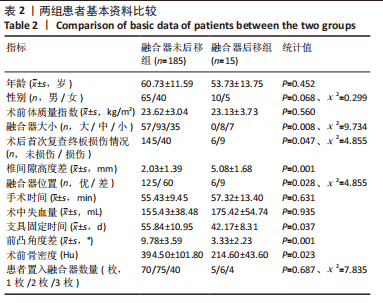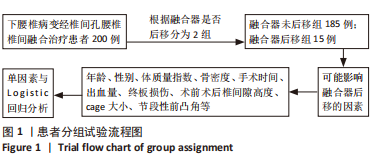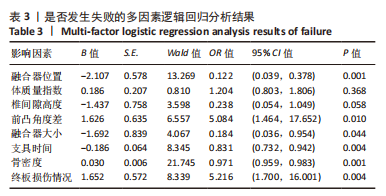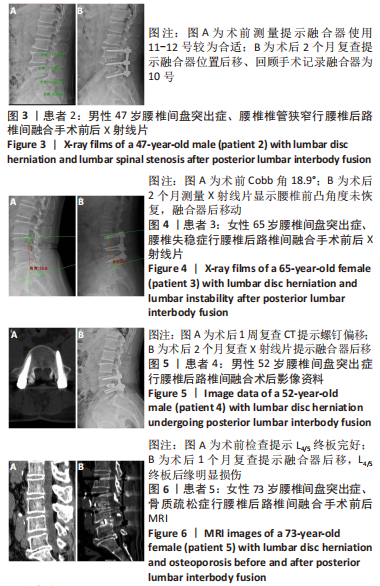[1] 王丹,蔡贤华,蒋欣浩,等.腰椎后路椎间融合内固定术后融合器后移处理23例[J].中国中医骨伤科杂志,2021,29(7):68-71,74.
[2] 邓乾兴,欧云生,朱勇,等.经椎间孔单节段腰椎椎间融合术后融合器下沉的危险因素分析[J].中华骨科杂志,2018,38(3):156-163.
[3] 吴李勇,王越,凌广烽,等.通道下经椎间孔腰椎椎体间融合术后融合器移位原因分析[J].颈腰痛杂志,2015,36(6):482-485.
[4] HU YH, NIU CC, HSIEH MK, et al. Cage positioning as a risk factor for posterior cage migration following transforaminal lumbar interbody fusion- an analysis of 953 cases. BMC Musculoskelet Disord. 2019;20(1):260.
[5] ZHOU ZJ, XIA P, ZHAO FD, et al. Endplate injury as a risk factor for cage retropulsion following transforaminal lumbar interbody fusion: An analysis of 1052 cases. Medicine (Baltimore). 2021;100(5):e24005.
[6] SCHREIBER JJ, ANDERSON PA, ROSAS HG, et al. Hounsfield units for assessing bone mineral density and strength: a tool for osteoporosis management. J Bone Joint Surg Am. 2011;93(11):1057-1063.
[7] 王辉,邹达,孙卓然,等.腰椎椎体松质骨和终板HU值对后路融合术后融合器沉降的预测价值[J].中华骨科杂志,2021,41(13):864-871.
[8] MORO T, KIKUCHI S, KONNO S, et al. An anatomic study of the lumbar plexus with respect to retroperitoneal endoscopic surgery. Spine (Phila Pa 1976). 2003; 8(5):423-428.
[9] 张建锋,周志杰,赵凤东,等.腰椎融合器后移的重要因素——间隙上终板后部损伤[J].中华骨科杂志,2016,36(14):914-920.
[10] 吴海昊,周春光,汤涛,等.单纯斜外侧腰椎椎间融合术后融合器沉降与腰椎矢状面参数的关系[J].中国脊柱脊髓杂志,2022,32(2):128-134.
[11] 李瑶,常恒瑞,刘振鹏,等.斜外侧腰椎间融合术后融合器沉降原因的研究进展[J].中华解剖与临床杂志,2021,26(1):115-119.
[12] CORNIOLA MV, JÄGERSBERG M, STIENEN MN, et al. Complete cage migration/subsidence into the adjacent vertebral body after posterior lumbar interbody fusion. J Clin Neurosci. 2015;22(3):597-598.
[13] 卢文灿,段春光,陶惠人,等.腰椎后路椎间融合术后融合器脱出的原因分析[J].中华骨与关节外科杂志,2019,6(12):335-361.
[14] LI H, WANG H, ZHU Y, et al. Incidence and risk factors of posterior cage migration following decompression and instrumented fusion for degenerative lumbar disorders. Medicine (Baltimore). 2017;96(33):7804.
[15] 郭新虎,孟妍,齐强,等.后路腰椎椎体间融合术后cage移位的危险因素分析及处理策略[J].中国脊柱脊髓杂志,2022,32(1):42-49.
[16] JIN L, CHEN Z, JIANG C, et al. Cage migration after unilateral instrumented transforaminal lumbar interbody fusion and associated risk factors:a modified measurement method. J Int Med Res. 2020;48(2):300060519867828.
[17] YANG JJ, YU CH, CHANG BS, et al. Subsidence and nonunion after anterior cervical interbody fusion using a stand alone polyetheretherketone (PEEK) cage. Clin Orthop Surg. 2011;3(1): 16-23.
[18] CHANG TS, CHANG JH, WANG CS, et al. Evaluation of unilateral cage -instrumented fixation for lumbar spine. J Orthop SurgRes. 2010;5(1):86.
[19] 张明彦,刘向阳,常磊,等.腰椎融合过程中终板损伤与术后融合器脱出的关系[J].中国组织工程究,2021,25(18):2856-2862.
[20] AOKI Y, YAMAGATA M, NAKAJIMA F, et al. Examining risk factors for posterior migration of fusion cages following transforaminal lumbar interbody fusion: a possible limitation of unilateral pedicle screw fixation. J Neurosurg Spine. 2010; 13(3): 381-387.
[21] ZHAO FD, WEI YM, ZHI SM, et al. Cage migration after transforaminal lumbar interbody fusion and factors related to it. Orthop Surg. 2012;4(4):227-232.
[22] PARK MK, KIM KT, BANG WS, et al. Risk factors for cage migration and cage retropulsion following transforaminal lumbar interbody fusion. Spine J. 2019; 19:437-447.
[23] PISANO AJ, FREDERICKS DR, STEELMAN T, et al. Lumbar disc height and vertebral Hounsfield units: association with interbody cage subsidence. Neurosurg Focus. 2020;49(2):E9.
[24] 赵凤东, 范顺武, DOLAN P, 等. 腰椎终板骨折特点及相关因素的实验研究[J]. 中华外科杂志,2006,44(16):1132-1135.
[25] HOU Y, YUAN W. Influences of disc degeneration and bone mineral density on the structural properties of lumbar end plates. Spine J. 2012;12(3):249-256.
[26] SATAKE K, KANEMURA T, NAKASHIMA H, et al. Cage subsidence in lateral interbody fusion with transpsoas approach: intraoperative endplate injury or late onset settling. Spine Surg Relat Res. 2017;1(4):203-210. |











